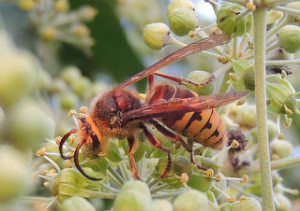European Hornets Are a Different Kind of Wasp
By Chris Williams on July 31, 2015.
We have an old gardening shed in back that is almost never used. When I opened it this morning, I was staring at a large, ball-shaped, papery nest up in a corner. I was also staring at several VERY large reddish-brown wasps. Needless to say, I hightailed it out of there. What kind of wasps are these? Too big to be yellowjackets.
T.T., Somersworth, NH

European Hornet
Based on your description of the size and the color, I would say they are European hornets, the largest of our social wasps at almost an inch long. Baldfaced hornets and yellowjackets can also make those large papery nests. Baldfaced hornets, however, are black and white and their nests are gray in color. European hornets’ nests are brown. The hornets themselves have a reddish-brown thorax with yellow and brown stripes on the abdomen. And yellowjackets…well you know what yellowjackets look like.
European hornets prefer to nest in hollow trees, but it’s not uncommon for them to build a nest in a shed or barn, or even in an attic or wall void. Inside a hollow tree, the nests don’t have a protective covering over the combs like they do when built out in the open.
A Wasp That is Active at Night
European hornets are pretty interesting for several reasons. Unlike our other wasps, this one is active at night and actually flies to lights. People often first notice them when they are banging against windows at night (see Large Wasps That Bang on Windows!). Their nocturnal habits make it tougher to treat the nest which would normally be done at night when the wasps are quiet. Fortunately, European hornets are not as aggressive as yellowjackets, but unfortunately, they have a large stinger and a painful sting if you threaten their nest.
These hornets are beneficial because they are predators on grasshoppers, flies, other large insects, and even yellowjackets. However, on the down side, they can cause problems in orchards and home gardens because they will chew holes in ripe fruit. They also girdle shrubs and small trees (especially lilacs) to feed on the sap.
To Kill The Wasps or Not to Kill the Wasps?
European hornets are not “in your face” like yellowjackets and seldom interact with people. Whether you decide to eliminate these wasps and their nest will depend on whether you intend to use that shed or the immediate area, whether you have children or pets that might interact with the hornets, and whether or not the wasps are causing damage to your trees or garden.
If you leave the hornets alone, the nest will die out by late summer. Worker wasps will die and a few wasps destined to be next year’s queens will leave the nest to spend the winter. The nest is not reused the following year so you will have your shed back. If you decide that you want the nest removed, give Colonial Pest a call. The sooner the nest is removed, the easier it will be.
Photo credit: orangeaurochs / Foter / CC BY